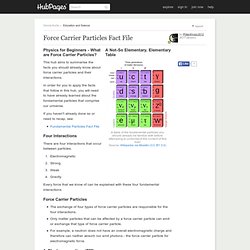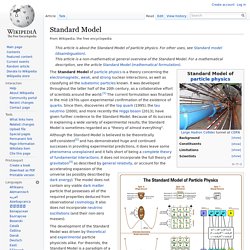

Chromoscope. Mass-Energy Scale. Richard Feynman - The.Character of Physical Law - Part 1 The Law of Gravitation (full version) Torus. A torus In geometry, a torus (pl. tori) is a surface of revolution generated by revolving a circle in three-dimensional space about an axis coplanar with the circle.

If the axis of revolution does not touch the circle, the surface has a ring shape and is called a ring torus or simply torus if the ring shape is implicit. In topology, a ring torus is homeomorphic to the Cartesian product of two circles: S1 × S1, and the latter is taken to be the definition in that context. It is a compact 2-manifold of genus 1. The ring torus is one way to embed this space into three-dimensional Euclidean space, but another way to do this is the Cartesian product of the embedding of S1 in the plane. The word torus comes from the Latin word meaning cushion.[1] Zero-point energy. Zero-point energy, also called quantum vacuum zero-point energy, is the lowest possible energy that a quantum mechanical physical system may have; it is the energy of its ground state.

All quantum mechanical systems undergo fluctuations even in their ground state and have an associated zero-point energy, a consequence of their wave-like nature. The uncertainty principle requires every physical system to have a zero-point energy greater than the minimum of its classical potential well. This results in motion even at absolute zero.
For example, liquid helium does not freeze under atmospheric pressure at any temperature because of its zero-point energy. History[edit] In 1900, Max Planck derived the formula for the energy of a single energy radiator, e.g., a vibrating atomic unit:[5] where is Planck's constant, is the frequency, k is Boltzmann's constant, and T is the absolute temperature. According to this expression, an atomic system at absolute zero retains an energy of ½hν. Varieties[edit] . Force Carrier Particles Fact File. Physics for Beginners - What are Force Carrier Particles?

This hub aims to summarise the facts you should already know about force carrier particles and their interactions. In order for you to apply the facts that follow in this hub, you will need to have already learned about the fundamental particles that comprise our universe. If you haven't already done so or need to recap, see: Fundamental Particles Fact File. Fundamental Particles Fact File. Keys 2 Cognition - Cognitive Processes. 47.

Trust what emerges from brainstorming. 48. Easily get in sync physically with people and things around you. To help us improve this assessment, please answer the following questions: Your comments: Your sex: Your age: This model tries to tap into development. Your MBTI(TM) type code? How did you decide on your type code? Your ID: (No ID? Warning! When you are ready, please click submit to view results... Copyright January 2005, Dario Nardi, with thanks to Linda V. CPEP - Contemporary Physics Education Project - CPEP. Standard Model. The Standard Model of particle physics is a theory concerning the electromagnetic, weak, and strong nuclear interactions, as well as classifying all the subatomic particles known.

It was developed throughout the latter half of the 20th century, as a collaborative effort of scientists around the world.[1] The current formulation was finalized in the mid-1970s upon experimental confirmation of the existence of quarks. Since then, discoveries of the top quark (1995), the tau neutrino (2000), and more recently the Higgs boson (2013), have given further credence to the Standard Model. Because of its success in explaining a wide variety of experimental results, the Standard Model is sometimes regarded as a "theory of almost everything". Historical background[edit] The Higgs mechanism is believed to give rise to the masses of all the elementary particles in the Standard Model. Overview[edit] Particle content[edit] Fermions[edit] Gauge bosons[edit] Higgs boson[edit] Main article: Higgs boson E.S. How To Study Physics.
Physics Study Guides - SparkNotes. The Particle Adventure.